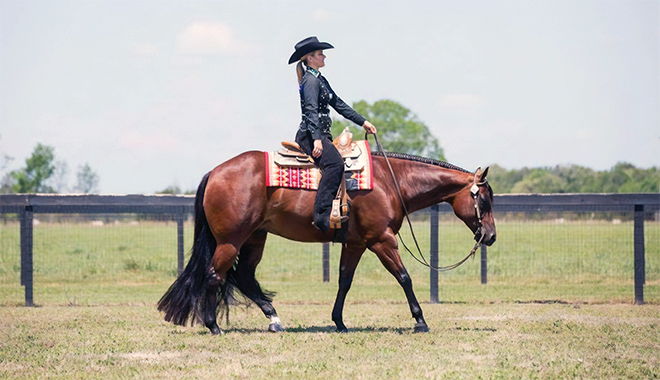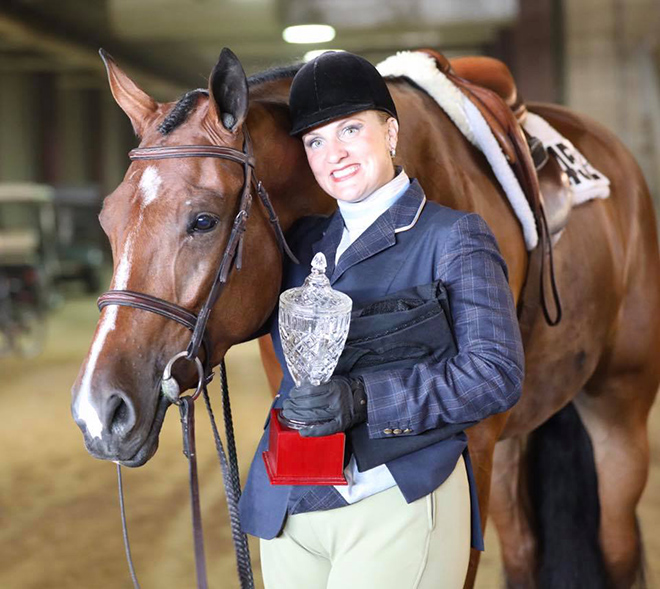
Western Pleasure and Hunter Under Saddle classes are designed to showcase a horse’s movement while working on the rail. Unlike Horsemanship or Equitation there’s no pattern to test the horse’s body control or responsiveness to cues.
“The culture has changed and people generally see the benefit of working the “rail” horses off the rail,” said Jonathan Himes. He and his wife Joanna operate JH Performance Horses in Albany, Georgia. “Some may feel that it can complicate things for horse or rider but in reality, it gives you more control and keeps the horses from premature burnout.”
Every time Himes rides, he works his horses off the rail. It’s only a few times each week that he schools them on the rail as they’ll be shown in competition. South Carolina trainer Kristy Starnes says that she and husband Jay also spend most of their time at least 10 feet off the rail.
Starnes rides all horses off the rail once they are green broke and out of the round pen. She does not start schooling young horses on the rail until they can easily be ridden all the way around the arena off the rail while maintaining the proper body position. Once a horse has mastered riding off the rail it can seamlessly transition to working on the rail.
“Practicing off the rail helps a horse in the show pen because the horse has to learn to not rely on the rail as a guide and fully listen to the rider,” she said. “It is easy for riders allow a horse to ‘lean’ their body toward the rail and just cruise around rather than forcing the horse to maintain proper form.”
Florida trainer Katy Jo Zuidema trains a lot of horses for competition in Hunter Under Saddle classes. She said she doesn’t consider it to be a “rail class.” Instead Zuidema focuses on teaching horses how to properly use their body and maneuver themselves correctly. She rides all her horses on the grass, without a rail.

“If I can make a hunt seat horse ride quietly in a field then he will be fine in the show pen,” she said. “Once a horse leans on the rail, they lose their quality of movement. And when a rider doesn’t steer or use their legs well enough the horse fades to the rail and creates a look that is unpolished.”
Schooling off the rail may sound easy. For many professionals, it’s part of their routine. But for youth, amateur and non-pro riders it can be more challenging than it sounds. The key is being able to ride straight lines and square corners to prevent horses from dropping a shoulder. In the article that follows, Himes, Starnes and Zuidema share how they work their horses off the rail at home to achieve that winning go in the show pen.
Stay Straight
To make the most of riding off the rail, it’s important to remember that the focus of the exercise is body control. Horses need to be able to hold their hip and stand up their shoulders, Himes said. This tends to be easier for hunt seat horses, according to Zuidema because these horses are ridden in the rider’s hands.
“Riding off the rail is a higher level of difficulty for western pleasure horses. The hunter horses have to have self-carriage, but they are also in my hands,” she said. “In western pleasure, it’s all self-carriage and muscle memory to teach the horse where to go.”
Straight lines sound easy. How hard can it be to ride from point A to point B? More difficult that it can appear. Starnes says that the most common mistake she sees non-pro riders make is swerving rather than staying on a linear track. One of the keys to riding straight is to look where you’re going. Riders tend to look down at their horse’s neck.
“When you look down you’re not going in a straight line because it drops your weight on their front end and impacts the horse’s ability to balance properly,” Starnes said.
She instructs clients to pick a specific fence or another visual aid and focus on riding to that point. The simple act of looking up and ahead significantly improves a horse and rider’s ability to ride straight. Riding horses is similar to riding a bike or driving a car. Both a car and bike move in the direction you’re looking. A horse will too.
Looking up and ahead may not be enough for some riders to guide their horse straight. A freshly dragged arena can provide a visual target to follow. But Starnes cautions that this will only work if the tractor operator drives in straight lines and the rider looks up and where they’re going, not down at the ground.
“Be intentional about your guide and body control,” Himes said. “Working on straight lines off the rail means they don’t have a rail to lean on.”

Straight lines are only one part of the equation. The other is teaching the horse to ride square corners. Arenas are built with round corners, which naturally encourages horses to drop their inside shoulder. Working on a track that’s off the rail, most trainers agree, gives riders an opportunity to execute square turns – an exercise that naturally requires horses to pick up their shoulder to stay balanced.
Horses need to drive off their backend and have a cadenced gait to successfully complete a square corner. That means making sure they’re moving forward on the approach to and turn through the corner. Looking where you’re going is critically important and asking your horse to slightly accelerate through the turn will reduce his chances of slowing down and breaking gait mid-way through the turn.
“Straight lines and square corners are two of the most effective ways to improve your horse’s body control,” Starnes said.
Counter Cantering and Counter Bending
Regularly asking a horse to counter cantering or counter bend during schooling sessions teaches the horse to move his front end asking them to push through with their front leg teach horses to stay balanced regardless of where they are in the pen.
Zuidema incorporates a lot of counter cantering into her training program. Asking horses to work on the wrong lead forces the horse to stand up straighter on his front end and drive from behind to maintain balance, especially through the corners. It’s important to remember that a true counter canter is not simply allowing the horse to canter on the wrong lead. When executed properly, it encourages better balance and correct movement. One of Zuidema’s favorite exercise for this is riding a circle, stopping, rolling back and then counter cantering.
“This really teaches the hunters to ride in my hand and uphill,” she said. “A lot of people forget that the purpose of a hunter horse is to go jump so teaching the horses to move forward and in the rider’s hands is important.”
Himes combines counter bending exercises with some lateral work. By asking his horses for lateral flexion – asking the horse to move off the inside leg and into the outside rein, he teaches them to work off their hind end.
The leg-yield, a forward and sideways maneuver with a slight bend in the opposite direction of travel, has its roots in dressage, but pleasure and all around trainers on the breed show circuit have been increasingly incorporating its use in training programs because it too encourages horses to balance.
Confidence Builder
Riding on the rail can become a crutch for horse and rider. By riding off the rail your horse will stay straighter and be more in tune with your cues in the show pen where there’s a lot of activity.
Getting a horse used to performing off the rail at home also gets them more comfortable with navigating traffic and passing other horses in the show pen. Starnes has observed many riders in the show pen who become nervous and tense when off the rail in a class. She says that practicing off the rail riders can gain confidence that they can place their horse anywhere in the arena and be in complete control.
Himes said that working off the rail at home prepares horses for navigating traffic in the show pen. That way the concept of changing pace and maneuvering away from the rail is not foreign to the horse when it happens at a show.
Being off the rail is not permission for a horse to wander but should be used to supple and test responsiveness to aides, Himes emphasized. Working off the rail should be intentional and riders need to guide horses accordingly.
Teaching body control and balance will improve any horse’s performance in the rail classes. However, with the proper fundamentals it also sets the horse up for success in any discipline.
“When you teach horses how to properly carry themselves you can ride them in any discipline you may want to try with them,” Zuidema concluded.



You must be logged in to post a comment Login